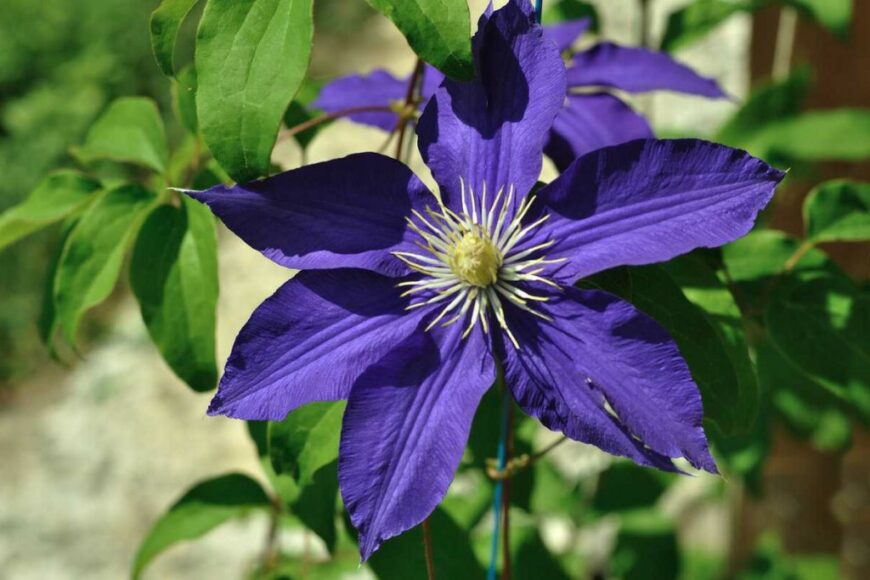
 Name: Clematis, Alternative names: Leather flower, Virgin's bower, Traveller's joy
Name: Clematis, Alternative names: Leather flower, Virgin's bower, Traveller's joy Family: Ranunculaceae (buttercup family)
Family: Ranunculaceae (buttercup family) Origins: Northern temperate regions of the world, with a concentration in Asia and North America
Origins: Northern temperate regions of the world, with a concentration in Asia and North America Humidity: Prefers moderate humidity, but can tolerate a range of conditions
Humidity: Prefers moderate humidity, but can tolerate a range of conditions Location: Full sun to partial shade
Location: Full sun to partial shade Soil: Rich, well-drained soil with a slightly acidic to neutral pH
Soil: Rich, well-drained soil with a slightly acidic to neutral pH Pests and diseases: Common pests include aphids, clematis wilt, and clematis nematodes. Common diseases include powdery mildew, clematis leaf spot, and clematis canker.
Pests and diseases: Common pests include aphids, clematis wilt, and clematis nematodes. Common diseases include powdery mildew, clematis leaf spot, and clematis canker. Care: Clematis requires regular watering, especially during hot, dry weather. It also needs to be fertilized annually. Pruning is necessary to maintain its shape and control its growth.
Care: Clematis requires regular watering, especially during hot, dry weather. It also needs to be fertilized annually. Pruning is necessary to maintain its shape and control its growth. Height of growth: Clematis vines can grow up to 30 feet tall.
Height of growth: Clematis vines can grow up to 30 feet tall. Planting in the soil: Clematis should be planted in a location where it will have plenty of room to grow. The planting hole should be twice as wide and deep as the root ball.
Planting in the soil: Clematis should be planted in a location where it will have plenty of room to grow. The planting hole should be twice as wide and deep as the root ball. Blooming: Clematis blooms in a variety of times, depending on the species
Blooming: Clematis blooms in a variety of times, depending on the speciesClematis, a versatile and enchanting flowering plant, belongs to the Ranunculaceae family. With over 300 species and numerous cultivars, Clematis offers a wide range of colors, shapes, and sizes. From vibrant purples to delicate whites, these climbing vines can transform any garden into a breathtaking display of floral beauty.
Benefits of Growing Clematis
Research indicates that the presence of flowering plants like Clematis in gardens can positively impact mental well-being. According to a study published in the Journal of Environmental Psychology, exposure to nature, including blooming flowers, is linked to reduced stress levels and increased feelings of happiness.
Content:
Planting Clematis: A Step-by-Step Guide
When it comes to planting Clematis, proper technique is crucial for optimal growth and blooming. Follow these steps to ensure your Clematis thrives:
1. Selecting the Right Location
Clematis prefers well-drained soil and benefits from sunlight on its foliage and cool roots. Choose a location where the base of the plant is shaded, either by other plants or a layer of mulch, to keep the roots cool.
2. Planting Depth Matters
Research conducted by horticulturists at the Royal Horticultural Society (RHS) suggests that planting depth is crucial for Clematis. Bury the plant deep enough to encourage strong root development and stability.
3. Watering and Fertilizing
Maintain consistent moisture in the soil, especially during dry periods. Fertilize Clematis with a balanced, all-purpose fertilizer during the growing season to promote vigorous growth.
Pruning Techniques for Clematis
Proper pruning is essential for Clematis to ensure a healthy and prolific blooming season. Different Clematis varieties require different pruning methods:
1. Group 1: Minimal Pruning
Clematis in Group 1, including the popular ‘Montana’ varieties, blooms on old wood. Prune lightly after flowering to shape and control size.
2. Group 2: Moderate Pruning
Clematis in Group 2, such as the ‘Nelly Moser,’ bloom on both old and new wood. Prune in late winter or early spring to encourage new growth.
3. Group 3: Hard Pruning
Varieties like ‘Jackmanii’ belong to Group 3, blooming on new wood. Prune these Clematis hard in late winter to early spring to stimulate vigorous new growth.
FAQ: Frequently Asked Questions
Can Clematis grow in containers?
Yes, Clematis adapts well to container gardening. Choose a large container with good drainage, use high-quality potting mix, and provide proper support.
How often should I water Clematis?
Clematis prefers consistently moist soil. Water regularly, especially during dry spells, and mulch to retain moisture.
Are there any pests or diseases to watch out for?
Clematis may face issues like aphids or powdery mildew. Regularly inspect the plants, and treat any problems promptly with appropriate measures.

